Research in Teenage Human Development: A Guide for Health Workers
VerifiedAdded on 2023/05/28
|12
|3127
|203
Essay
AI Summary
This essay examines the significance of understanding research in teenage human development for health and social care workers. It delves into typical teenage behaviors, highlighting risk-taking and experimentation as identity-shaping processes. The essay explores biological and social influences, referencing the nature/nurture debate and attachment theories. It also outlines conditions like ADHD and alcoholism that can lead to atypical development patterns, discussing the impact of parental influence and genetic predispositions. Furthermore, the essay emphasizes how research informs practical management strategies, such as creating supportive environments and promoting positive behavior, while also guiding interventions for conditions like ADHD, thereby improving the social and academic development of teenagers. The role of Desklib is to provide students access to past papers and solved assignments for their academic needs.
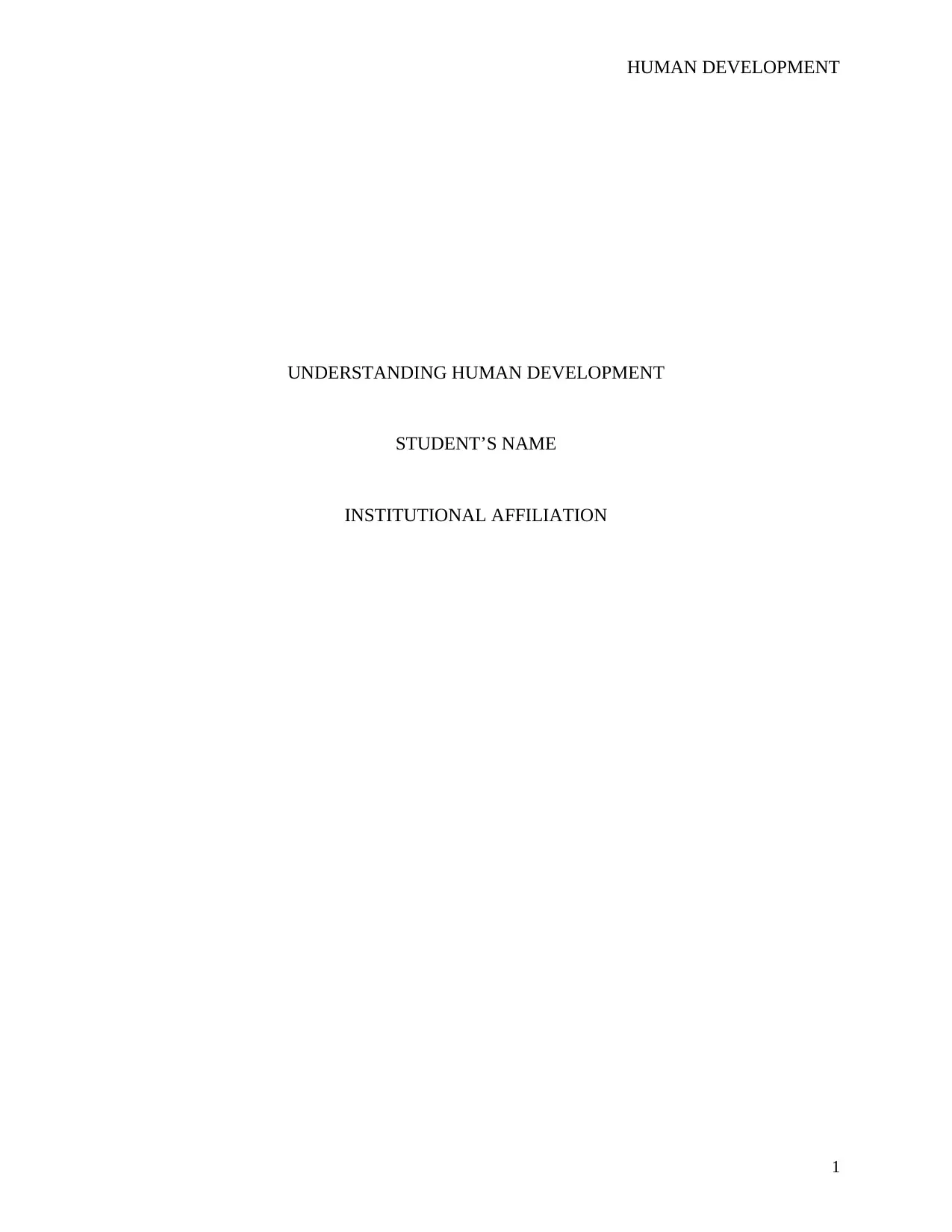
HUMAN DEVELOPMENT
UNDERSTANDING HUMAN DEVELOPMENT
STUDENT’S NAME
INSTITUTIONAL AFFILIATION
1
UNDERSTANDING HUMAN DEVELOPMENT
STUDENT’S NAME
INSTITUTIONAL AFFILIATION
1
Paraphrase This Document
Need a fresh take? Get an instant paraphrase of this document with our AI Paraphraser
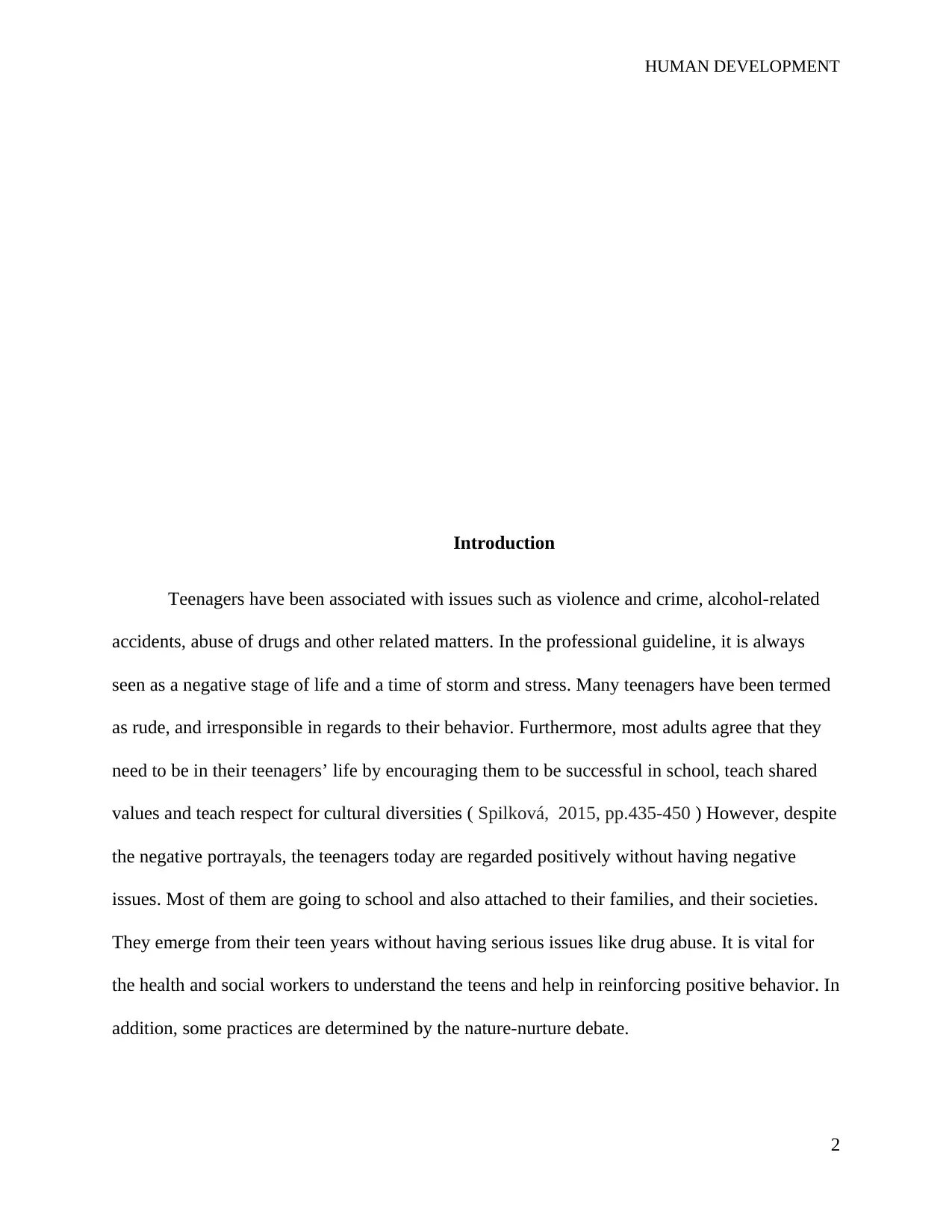
HUMAN DEVELOPMENT
Introduction
Teenagers have been associated with issues such as violence and crime, alcohol-related
accidents, abuse of drugs and other related matters. In the professional guideline, it is always
seen as a negative stage of life and a time of storm and stress. Many teenagers have been termed
as rude, and irresponsible in regards to their behavior. Furthermore, most adults agree that they
need to be in their teenagers’ life by encouraging them to be successful in school, teach shared
values and teach respect for cultural diversities ( Spilková, 2015, pp.435-450 ) However, despite
the negative portrayals, the teenagers today are regarded positively without having negative
issues. Most of them are going to school and also attached to their families, and their societies.
They emerge from their teen years without having serious issues like drug abuse. It is vital for
the health and social workers to understand the teens and help in reinforcing positive behavior. In
addition, some practices are determined by the nature-nurture debate.
2
Introduction
Teenagers have been associated with issues such as violence and crime, alcohol-related
accidents, abuse of drugs and other related matters. In the professional guideline, it is always
seen as a negative stage of life and a time of storm and stress. Many teenagers have been termed
as rude, and irresponsible in regards to their behavior. Furthermore, most adults agree that they
need to be in their teenagers’ life by encouraging them to be successful in school, teach shared
values and teach respect for cultural diversities ( Spilková, 2015, pp.435-450 ) However, despite
the negative portrayals, the teenagers today are regarded positively without having negative
issues. Most of them are going to school and also attached to their families, and their societies.
They emerge from their teen years without having serious issues like drug abuse. It is vital for
the health and social workers to understand the teens and help in reinforcing positive behavior. In
addition, some practices are determined by the nature-nurture debate.
2
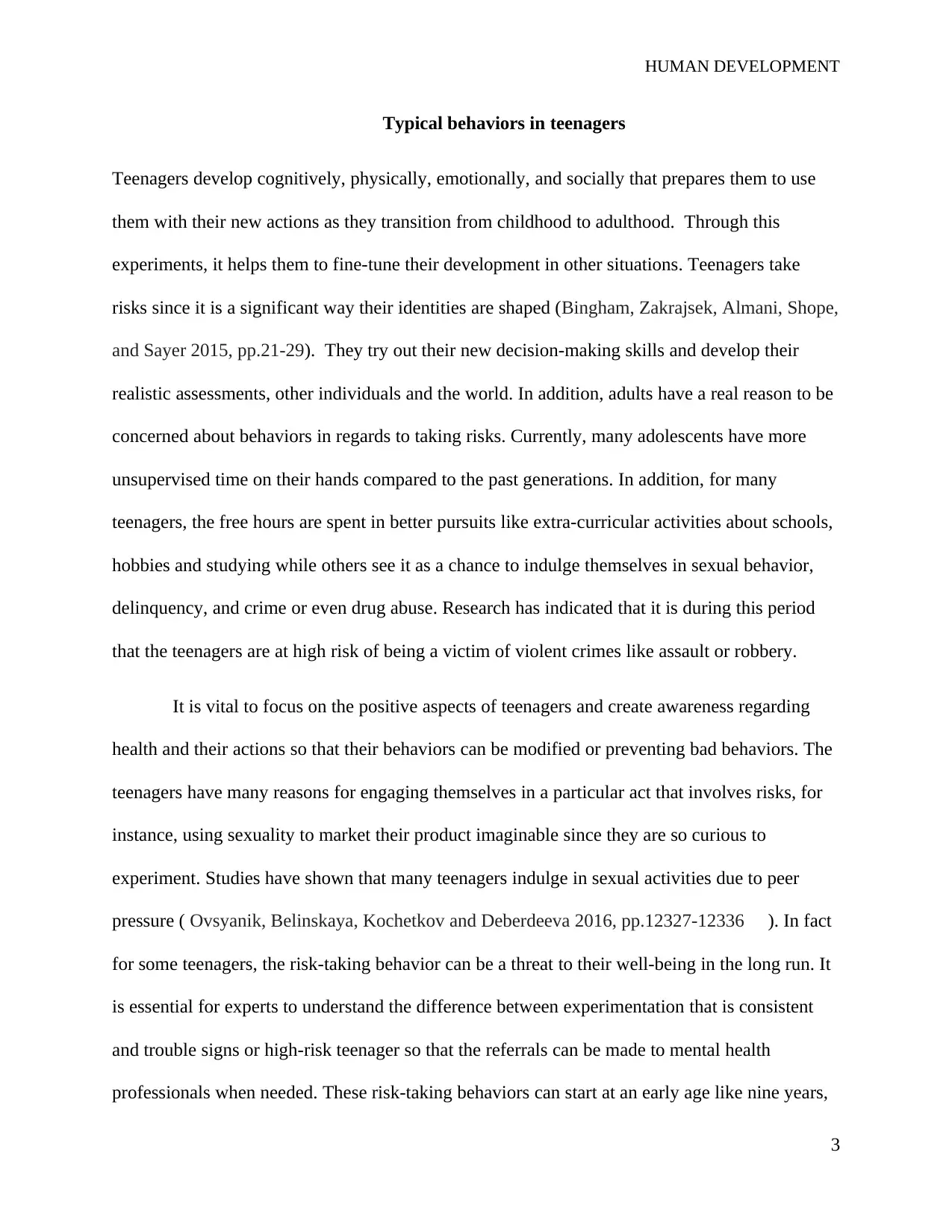
HUMAN DEVELOPMENT
Typical behaviors in teenagers
Teenagers develop cognitively, physically, emotionally, and socially that prepares them to use
them with their new actions as they transition from childhood to adulthood. Through this
experiments, it helps them to fine-tune their development in other situations. Teenagers take
risks since it is a significant way their identities are shaped (Bingham, Zakrajsek, Almani, Shope,
and Sayer 2015, pp.21-29). They try out their new decision-making skills and develop their
realistic assessments, other individuals and the world. In addition, adults have a real reason to be
concerned about behaviors in regards to taking risks. Currently, many adolescents have more
unsupervised time on their hands compared to the past generations. In addition, for many
teenagers, the free hours are spent in better pursuits like extra-curricular activities about schools,
hobbies and studying while others see it as a chance to indulge themselves in sexual behavior,
delinquency, and crime or even drug abuse. Research has indicated that it is during this period
that the teenagers are at high risk of being a victim of violent crimes like assault or robbery.
It is vital to focus on the positive aspects of teenagers and create awareness regarding
health and their actions so that their behaviors can be modified or preventing bad behaviors. The
teenagers have many reasons for engaging themselves in a particular act that involves risks, for
instance, using sexuality to market their product imaginable since they are so curious to
experiment. Studies have shown that many teenagers indulge in sexual activities due to peer
pressure ( Ovsyanik, Belinskaya, Kochetkov and Deberdeeva 2016, pp.12327-12336 ). In fact
for some teenagers, the risk-taking behavior can be a threat to their well-being in the long run. It
is essential for experts to understand the difference between experimentation that is consistent
and trouble signs or high-risk teenager so that the referrals can be made to mental health
professionals when needed. These risk-taking behaviors can start at an early age like nine years,
3
Typical behaviors in teenagers
Teenagers develop cognitively, physically, emotionally, and socially that prepares them to use
them with their new actions as they transition from childhood to adulthood. Through this
experiments, it helps them to fine-tune their development in other situations. Teenagers take
risks since it is a significant way their identities are shaped (Bingham, Zakrajsek, Almani, Shope,
and Sayer 2015, pp.21-29). They try out their new decision-making skills and develop their
realistic assessments, other individuals and the world. In addition, adults have a real reason to be
concerned about behaviors in regards to taking risks. Currently, many adolescents have more
unsupervised time on their hands compared to the past generations. In addition, for many
teenagers, the free hours are spent in better pursuits like extra-curricular activities about schools,
hobbies and studying while others see it as a chance to indulge themselves in sexual behavior,
delinquency, and crime or even drug abuse. Research has indicated that it is during this period
that the teenagers are at high risk of being a victim of violent crimes like assault or robbery.
It is vital to focus on the positive aspects of teenagers and create awareness regarding
health and their actions so that their behaviors can be modified or preventing bad behaviors. The
teenagers have many reasons for engaging themselves in a particular act that involves risks, for
instance, using sexuality to market their product imaginable since they are so curious to
experiment. Studies have shown that many teenagers indulge in sexual activities due to peer
pressure ( Ovsyanik, Belinskaya, Kochetkov and Deberdeeva 2016, pp.12327-12336 ). In fact
for some teenagers, the risk-taking behavior can be a threat to their well-being in the long run. It
is essential for experts to understand the difference between experimentation that is consistent
and trouble signs or high-risk teenager so that the referrals can be made to mental health
professionals when needed. These risk-taking behaviors can start at an early age like nine years,
3
⊘ This is a preview!⊘
Do you want full access?
Subscribe today to unlock all pages.

Trusted by 1+ million students worldwide

HUMAN DEVELOPMENT
and it usually happens to teenagers who engage in the same response. In this situation, the family
must consider referring the teenager to a mental expert in order to get solutions for the pressing
issues facing them.
Additionally, teenagers who are at a higher risk for adverse results tend to indulge in different
behaviors like abuse of drugs and unprotected sexual intercourse at an early age and always have
many antecedent risk elements in common like low self-esteem and performing poorly in school.
The main areas of concern for high-risk teenagers are drug abuse and alcohol, sexually
transmitted illness, school dropout, delinquency, and violence ( Havighurst, Kehoe and Harley
2015, pp.148-158). Furthermore, teens who start using drugs early depend on drugs and alcohol
to ease depression or anxiety feelings. Parental drug abuse is a risk element for the development
of drug abuse issues for the teenagers in regards to specific parenting and management
characteristics of the family. This encompasses lack of supervision of the teens, teen
expectations which are unclear, and no reward for positive behavior.
Additionally, dropping out of can be the worst decision a teen could make which have
disastrous impacts regarding economics in future ( Park, Chira, Miller and Nugent 2015, pp.69-
77 ). Therefore, it is necessary for guardians to communicate with their teens and educate them
on matters of pregnancy and use of contraceptive. Different patterns of delinquency and
antisocial actions like shoplifting have been identified. For many teenagers who act out, their
work reflects a gap between social and biological maturity. The detachment theory of parenting
the teenagers suggests that the guardians can also act as an influence in the behavior of the teen
that is to teach them responsible behavior. This means that the parents choose what they consider
as responsible and include what is right and what is wrong with regards to the teen's behavior.
The teenagers ranging from 9-13 years is the maturity of detachment parenting (Sibley et
4
and it usually happens to teenagers who engage in the same response. In this situation, the family
must consider referring the teenager to a mental expert in order to get solutions for the pressing
issues facing them.
Additionally, teenagers who are at a higher risk for adverse results tend to indulge in different
behaviors like abuse of drugs and unprotected sexual intercourse at an early age and always have
many antecedent risk elements in common like low self-esteem and performing poorly in school.
The main areas of concern for high-risk teenagers are drug abuse and alcohol, sexually
transmitted illness, school dropout, delinquency, and violence ( Havighurst, Kehoe and Harley
2015, pp.148-158). Furthermore, teens who start using drugs early depend on drugs and alcohol
to ease depression or anxiety feelings. Parental drug abuse is a risk element for the development
of drug abuse issues for the teenagers in regards to specific parenting and management
characteristics of the family. This encompasses lack of supervision of the teens, teen
expectations which are unclear, and no reward for positive behavior.
Additionally, dropping out of can be the worst decision a teen could make which have
disastrous impacts regarding economics in future ( Park, Chira, Miller and Nugent 2015, pp.69-
77 ). Therefore, it is necessary for guardians to communicate with their teens and educate them
on matters of pregnancy and use of contraceptive. Different patterns of delinquency and
antisocial actions like shoplifting have been identified. For many teenagers who act out, their
work reflects a gap between social and biological maturity. The detachment theory of parenting
the teenagers suggests that the guardians can also act as an influence in the behavior of the teen
that is to teach them responsible behavior. This means that the parents choose what they consider
as responsible and include what is right and what is wrong with regards to the teen's behavior.
The teenagers ranging from 9-13 years is the maturity of detachment parenting (Sibley et
4
Paraphrase This Document
Need a fresh take? Get an instant paraphrase of this document with our AI Paraphraser
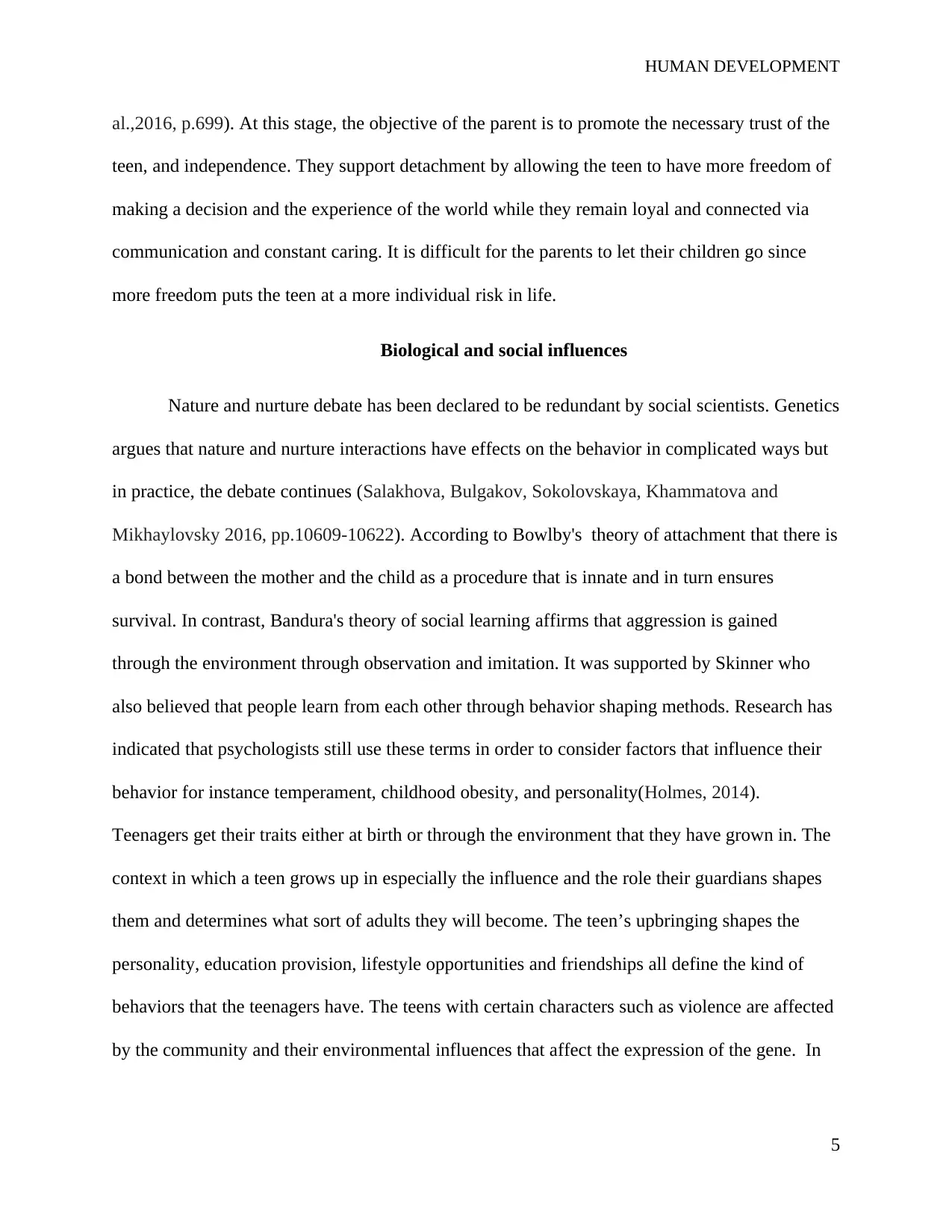
HUMAN DEVELOPMENT
al.,2016, p.699). At this stage, the objective of the parent is to promote the necessary trust of the
teen, and independence. They support detachment by allowing the teen to have more freedom of
making a decision and the experience of the world while they remain loyal and connected via
communication and constant caring. It is difficult for the parents to let their children go since
more freedom puts the teen at a more individual risk in life.
Biological and social influences
Nature and nurture debate has been declared to be redundant by social scientists. Genetics
argues that nature and nurture interactions have effects on the behavior in complicated ways but
in practice, the debate continues (Salakhova, Bulgakov, Sokolovskaya, Khammatova and
Mikhaylovsky 2016, pp.10609-10622). According to Bowlby's theory of attachment that there is
a bond between the mother and the child as a procedure that is innate and in turn ensures
survival. In contrast, Bandura's theory of social learning affirms that aggression is gained
through the environment through observation and imitation. It was supported by Skinner who
also believed that people learn from each other through behavior shaping methods. Research has
indicated that psychologists still use these terms in order to consider factors that influence their
behavior for instance temperament, childhood obesity, and personality(Holmes, 2014).
Teenagers get their traits either at birth or through the environment that they have grown in. The
context in which a teen grows up in especially the influence and the role their guardians shapes
them and determines what sort of adults they will become. The teen’s upbringing shapes the
personality, education provision, lifestyle opportunities and friendships all define the kind of
behaviors that the teenagers have. The teens with certain characters such as violence are affected
by the community and their environmental influences that affect the expression of the gene. In
5
al.,2016, p.699). At this stage, the objective of the parent is to promote the necessary trust of the
teen, and independence. They support detachment by allowing the teen to have more freedom of
making a decision and the experience of the world while they remain loyal and connected via
communication and constant caring. It is difficult for the parents to let their children go since
more freedom puts the teen at a more individual risk in life.
Biological and social influences
Nature and nurture debate has been declared to be redundant by social scientists. Genetics
argues that nature and nurture interactions have effects on the behavior in complicated ways but
in practice, the debate continues (Salakhova, Bulgakov, Sokolovskaya, Khammatova and
Mikhaylovsky 2016, pp.10609-10622). According to Bowlby's theory of attachment that there is
a bond between the mother and the child as a procedure that is innate and in turn ensures
survival. In contrast, Bandura's theory of social learning affirms that aggression is gained
through the environment through observation and imitation. It was supported by Skinner who
also believed that people learn from each other through behavior shaping methods. Research has
indicated that psychologists still use these terms in order to consider factors that influence their
behavior for instance temperament, childhood obesity, and personality(Holmes, 2014).
Teenagers get their traits either at birth or through the environment that they have grown in. The
context in which a teen grows up in especially the influence and the role their guardians shapes
them and determines what sort of adults they will become. The teen’s upbringing shapes the
personality, education provision, lifestyle opportunities and friendships all define the kind of
behaviors that the teenagers have. The teens with certain characters such as violence are affected
by the community and their environmental influences that affect the expression of the gene. In
5
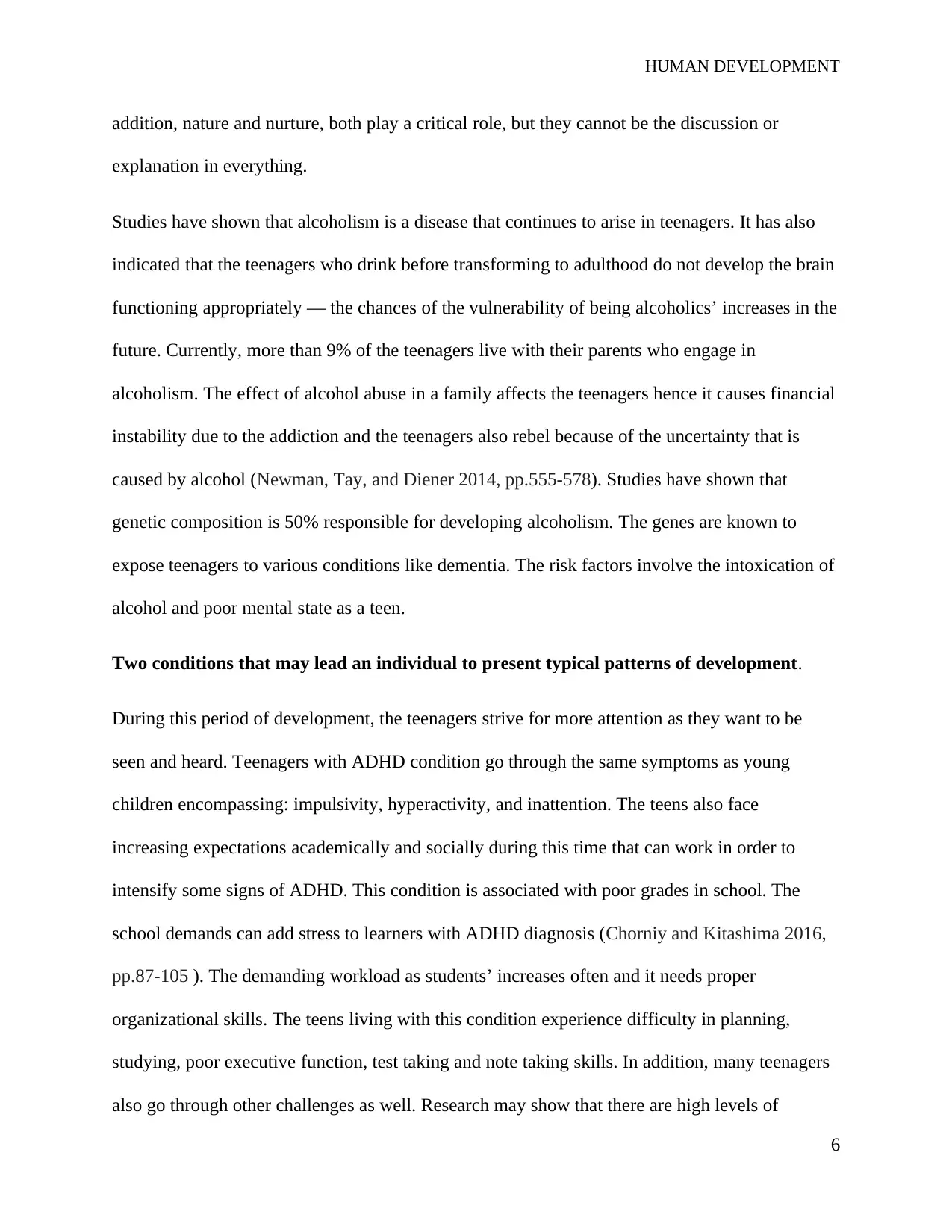
HUMAN DEVELOPMENT
addition, nature and nurture, both play a critical role, but they cannot be the discussion or
explanation in everything.
Studies have shown that alcoholism is a disease that continues to arise in teenagers. It has also
indicated that the teenagers who drink before transforming to adulthood do not develop the brain
functioning appropriately — the chances of the vulnerability of being alcoholics’ increases in the
future. Currently, more than 9% of the teenagers live with their parents who engage in
alcoholism. The effect of alcohol abuse in a family affects the teenagers hence it causes financial
instability due to the addiction and the teenagers also rebel because of the uncertainty that is
caused by alcohol (Newman, Tay, and Diener 2014, pp.555-578). Studies have shown that
genetic composition is 50% responsible for developing alcoholism. The genes are known to
expose teenagers to various conditions like dementia. The risk factors involve the intoxication of
alcohol and poor mental state as a teen.
Two conditions that may lead an individual to present typical patterns of development.
During this period of development, the teenagers strive for more attention as they want to be
seen and heard. Teenagers with ADHD condition go through the same symptoms as young
children encompassing: impulsivity, hyperactivity, and inattention. The teens also face
increasing expectations academically and socially during this time that can work in order to
intensify some signs of ADHD. This condition is associated with poor grades in school. The
school demands can add stress to learners with ADHD diagnosis (Chorniy and Kitashima 2016,
pp.87-105 ). The demanding workload as students’ increases often and it needs proper
organizational skills. The teens living with this condition experience difficulty in planning,
studying, poor executive function, test taking and note taking skills. In addition, many teenagers
also go through other challenges as well. Research may show that there are high levels of
6
addition, nature and nurture, both play a critical role, but they cannot be the discussion or
explanation in everything.
Studies have shown that alcoholism is a disease that continues to arise in teenagers. It has also
indicated that the teenagers who drink before transforming to adulthood do not develop the brain
functioning appropriately — the chances of the vulnerability of being alcoholics’ increases in the
future. Currently, more than 9% of the teenagers live with their parents who engage in
alcoholism. The effect of alcohol abuse in a family affects the teenagers hence it causes financial
instability due to the addiction and the teenagers also rebel because of the uncertainty that is
caused by alcohol (Newman, Tay, and Diener 2014, pp.555-578). Studies have shown that
genetic composition is 50% responsible for developing alcoholism. The genes are known to
expose teenagers to various conditions like dementia. The risk factors involve the intoxication of
alcohol and poor mental state as a teen.
Two conditions that may lead an individual to present typical patterns of development.
During this period of development, the teenagers strive for more attention as they want to be
seen and heard. Teenagers with ADHD condition go through the same symptoms as young
children encompassing: impulsivity, hyperactivity, and inattention. The teens also face
increasing expectations academically and socially during this time that can work in order to
intensify some signs of ADHD. This condition is associated with poor grades in school. The
school demands can add stress to learners with ADHD diagnosis (Chorniy and Kitashima 2016,
pp.87-105 ). The demanding workload as students’ increases often and it needs proper
organizational skills. The teens living with this condition experience difficulty in planning,
studying, poor executive function, test taking and note taking skills. In addition, many teenagers
also go through other challenges as well. Research may show that there are high levels of
6
⊘ This is a preview!⊘
Do you want full access?
Subscribe today to unlock all pages.

Trusted by 1+ million students worldwide
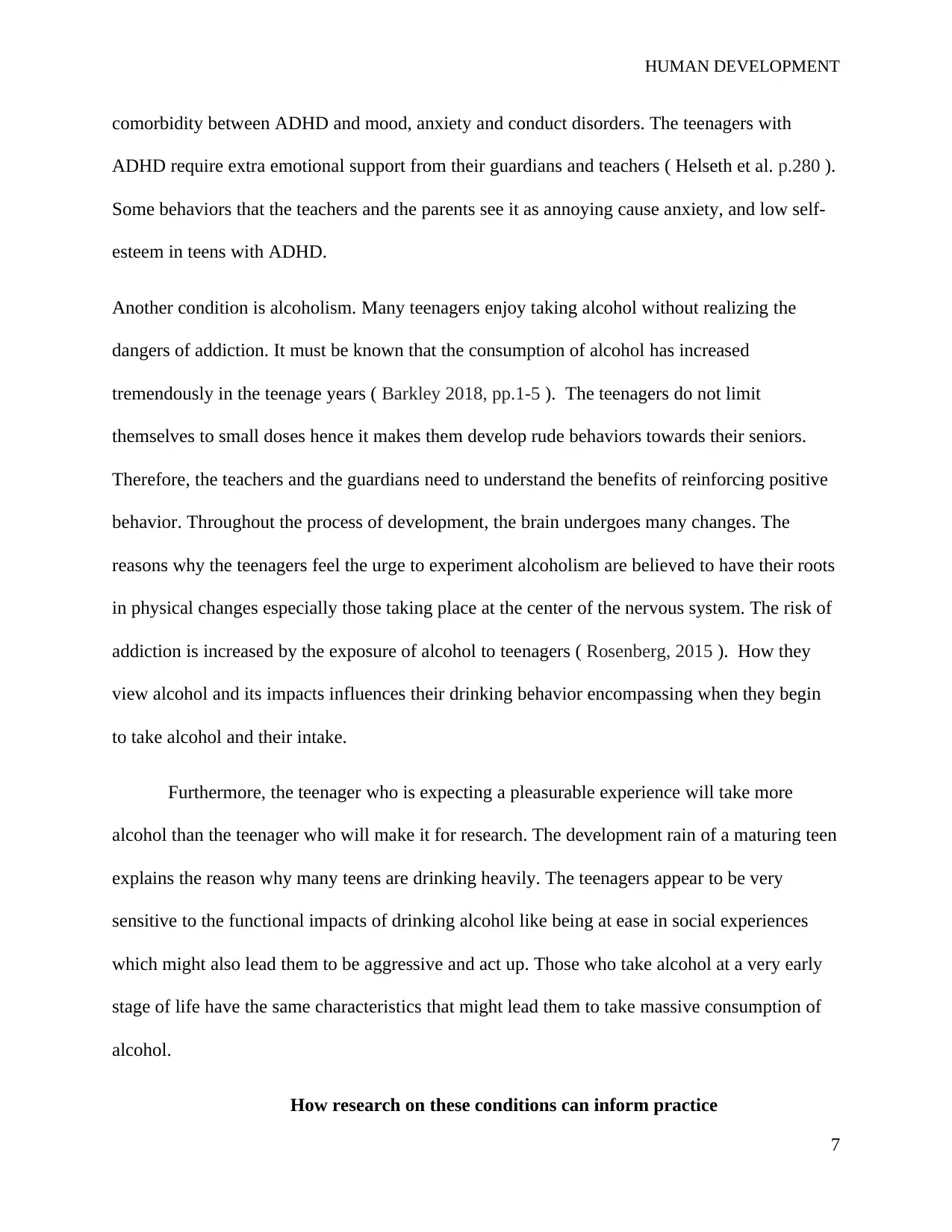
HUMAN DEVELOPMENT
comorbidity between ADHD and mood, anxiety and conduct disorders. The teenagers with
ADHD require extra emotional support from their guardians and teachers ( Helseth et al. p.280 ).
Some behaviors that the teachers and the parents see it as annoying cause anxiety, and low self-
esteem in teens with ADHD.
Another condition is alcoholism. Many teenagers enjoy taking alcohol without realizing the
dangers of addiction. It must be known that the consumption of alcohol has increased
tremendously in the teenage years ( Barkley 2018, pp.1-5 ). The teenagers do not limit
themselves to small doses hence it makes them develop rude behaviors towards their seniors.
Therefore, the teachers and the guardians need to understand the benefits of reinforcing positive
behavior. Throughout the process of development, the brain undergoes many changes. The
reasons why the teenagers feel the urge to experiment alcoholism are believed to have their roots
in physical changes especially those taking place at the center of the nervous system. The risk of
addiction is increased by the exposure of alcohol to teenagers ( Rosenberg, 2015 ). How they
view alcohol and its impacts influences their drinking behavior encompassing when they begin
to take alcohol and their intake.
Furthermore, the teenager who is expecting a pleasurable experience will take more
alcohol than the teenager who will make it for research. The development rain of a maturing teen
explains the reason why many teens are drinking heavily. The teenagers appear to be very
sensitive to the functional impacts of drinking alcohol like being at ease in social experiences
which might also lead them to be aggressive and act up. Those who take alcohol at a very early
stage of life have the same characteristics that might lead them to take massive consumption of
alcohol.
How research on these conditions can inform practice
7
comorbidity between ADHD and mood, anxiety and conduct disorders. The teenagers with
ADHD require extra emotional support from their guardians and teachers ( Helseth et al. p.280 ).
Some behaviors that the teachers and the parents see it as annoying cause anxiety, and low self-
esteem in teens with ADHD.
Another condition is alcoholism. Many teenagers enjoy taking alcohol without realizing the
dangers of addiction. It must be known that the consumption of alcohol has increased
tremendously in the teenage years ( Barkley 2018, pp.1-5 ). The teenagers do not limit
themselves to small doses hence it makes them develop rude behaviors towards their seniors.
Therefore, the teachers and the guardians need to understand the benefits of reinforcing positive
behavior. Throughout the process of development, the brain undergoes many changes. The
reasons why the teenagers feel the urge to experiment alcoholism are believed to have their roots
in physical changes especially those taking place at the center of the nervous system. The risk of
addiction is increased by the exposure of alcohol to teenagers ( Rosenberg, 2015 ). How they
view alcohol and its impacts influences their drinking behavior encompassing when they begin
to take alcohol and their intake.
Furthermore, the teenager who is expecting a pleasurable experience will take more
alcohol than the teenager who will make it for research. The development rain of a maturing teen
explains the reason why many teens are drinking heavily. The teenagers appear to be very
sensitive to the functional impacts of drinking alcohol like being at ease in social experiences
which might also lead them to be aggressive and act up. Those who take alcohol at a very early
stage of life have the same characteristics that might lead them to take massive consumption of
alcohol.
How research on these conditions can inform practice
7
Paraphrase This Document
Need a fresh take? Get an instant paraphrase of this document with our AI Paraphraser

HUMAN DEVELOPMENT
Managing teenagers is not an easy task, but individuals work hard to ensure that they are
safe. Getting information is essential in understanding the teenager's conditions and its
management (Rief, 2016). The research shows that its part of working with the health experts to
have a management plan that can assist in the social and academic development of the teenagers.
This plan might encompass the strategies of the actions, both at home and at school, assistance
for any other learning behavior and emotional issues that the teenager might have, and treatment.
For instance, the experts will not have a hard time dealing with ADHD teenagers if they a good
comprehension of what is needed. They need to ensure that they have the teens attention and also
maintain eye contact. Also, the instructions must be short and clear with the least number of
procedures. It is also important to cooperate with the teen by keeping a calm face and voice.
Besides, giving healthy meal options to assist with the alertness and energy. In addition, social
skills can b improved by teaching the teen about the consequences of specific activities for
instance little time on the computer. Encouraging positive behavior is essential since it acts as a
positive motivator. When the positive behavior is seen and praised, the teen will be able to
understand what he is required to do (Sasaki and Kim 2017,pp.4-22). During this time, the
parents must take full responsibility of their teens so that positive behavior can be nurtured.
Many studies have found a positive relationship between the teen and a caring adult since there is
a firm emotional attachment, for example, the relationship between a caring teacher and the
student.
Alcoholism is a severe condition that has affected teens globally. This causes many teens
to drop out of school and engage in activities that could harm them in the future. Health and
social workers must understand them and help them to focus on their future. They should
encourage teens and educate them on matters regarding alcohol, dementia and other conditions
8
Managing teenagers is not an easy task, but individuals work hard to ensure that they are
safe. Getting information is essential in understanding the teenager's conditions and its
management (Rief, 2016). The research shows that its part of working with the health experts to
have a management plan that can assist in the social and academic development of the teenagers.
This plan might encompass the strategies of the actions, both at home and at school, assistance
for any other learning behavior and emotional issues that the teenager might have, and treatment.
For instance, the experts will not have a hard time dealing with ADHD teenagers if they a good
comprehension of what is needed. They need to ensure that they have the teens attention and also
maintain eye contact. Also, the instructions must be short and clear with the least number of
procedures. It is also important to cooperate with the teen by keeping a calm face and voice.
Besides, giving healthy meal options to assist with the alertness and energy. In addition, social
skills can b improved by teaching the teen about the consequences of specific activities for
instance little time on the computer. Encouraging positive behavior is essential since it acts as a
positive motivator. When the positive behavior is seen and praised, the teen will be able to
understand what he is required to do (Sasaki and Kim 2017,pp.4-22). During this time, the
parents must take full responsibility of their teens so that positive behavior can be nurtured.
Many studies have found a positive relationship between the teen and a caring adult since there is
a firm emotional attachment, for example, the relationship between a caring teacher and the
student.
Alcoholism is a severe condition that has affected teens globally. This causes many teens
to drop out of school and engage in activities that could harm them in the future. Health and
social workers must understand them and help them to focus on their future. They should
encourage teens and educate them on matters regarding alcohol, dementia and other conditions
8
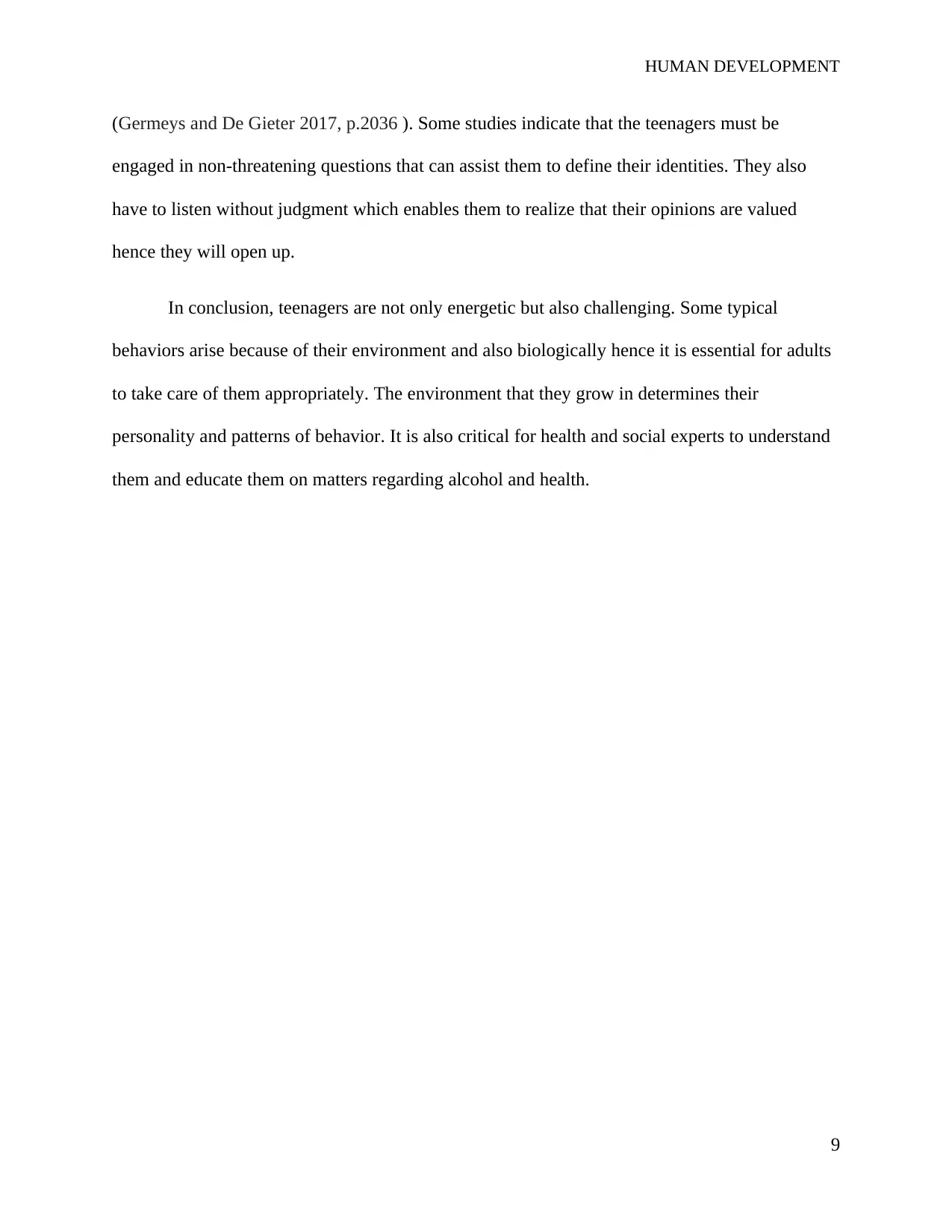
HUMAN DEVELOPMENT
(Germeys and De Gieter 2017, p.2036 ). Some studies indicate that the teenagers must be
engaged in non-threatening questions that can assist them to define their identities. They also
have to listen without judgment which enables them to realize that their opinions are valued
hence they will open up.
In conclusion, teenagers are not only energetic but also challenging. Some typical
behaviors arise because of their environment and also biologically hence it is essential for adults
to take care of them appropriately. The environment that they grow in determines their
personality and patterns of behavior. It is also critical for health and social experts to understand
them and educate them on matters regarding alcohol and health.
9
(Germeys and De Gieter 2017, p.2036 ). Some studies indicate that the teenagers must be
engaged in non-threatening questions that can assist them to define their identities. They also
have to listen without judgment which enables them to realize that their opinions are valued
hence they will open up.
In conclusion, teenagers are not only energetic but also challenging. Some typical
behaviors arise because of their environment and also biologically hence it is essential for adults
to take care of them appropriately. The environment that they grow in determines their
personality and patterns of behavior. It is also critical for health and social experts to understand
them and educate them on matters regarding alcohol and health.
9
⊘ This is a preview!⊘
Do you want full access?
Subscribe today to unlock all pages.

Trusted by 1+ million students worldwide
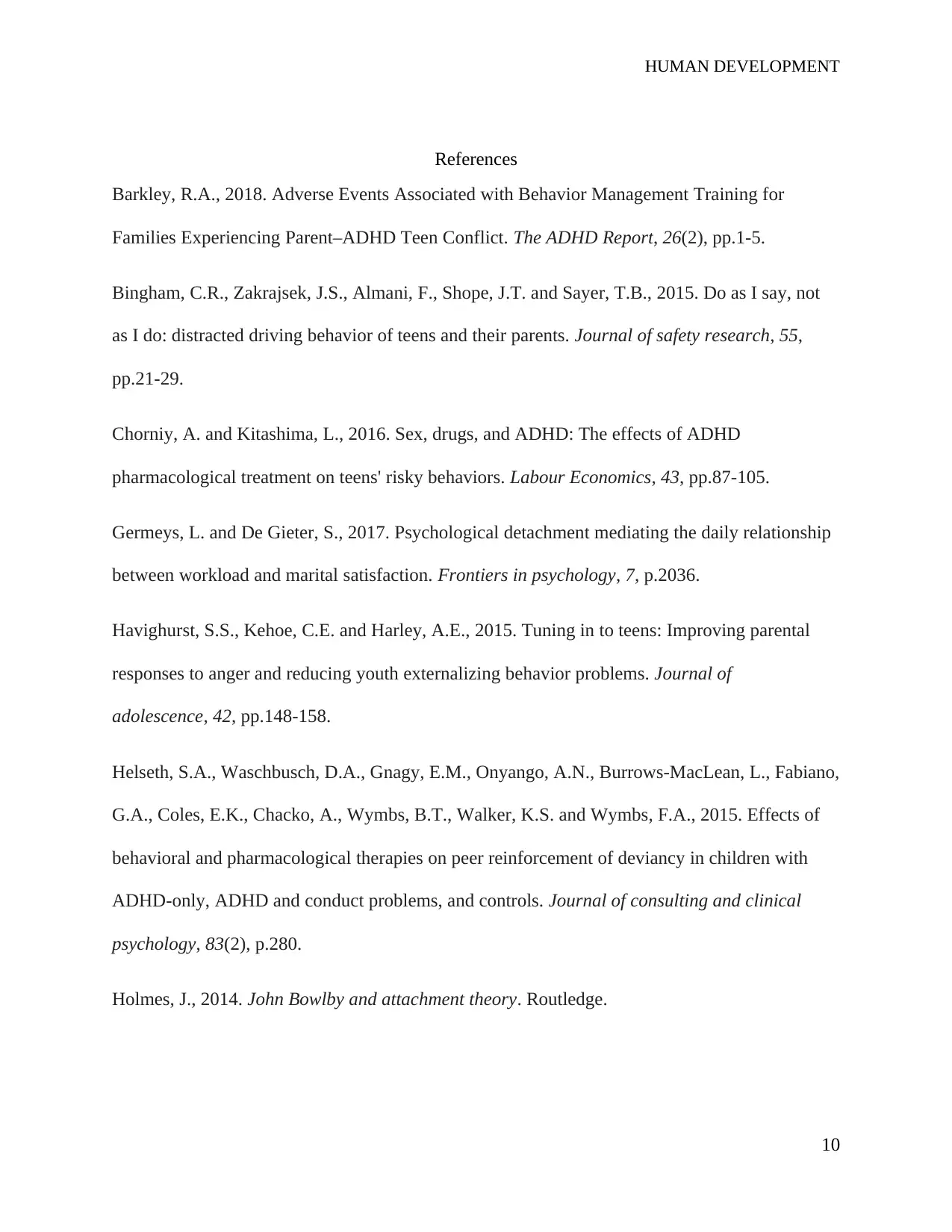
HUMAN DEVELOPMENT
References
Barkley, R.A., 2018. Adverse Events Associated with Behavior Management Training for
Families Experiencing Parent–ADHD Teen Conflict. The ADHD Report, 26(2), pp.1-5.
Bingham, C.R., Zakrajsek, J.S., Almani, F., Shope, J.T. and Sayer, T.B., 2015. Do as I say, not
as I do: distracted driving behavior of teens and their parents. Journal of safety research, 55,
pp.21-29.
Chorniy, A. and Kitashima, L., 2016. Sex, drugs, and ADHD: The effects of ADHD
pharmacological treatment on teens' risky behaviors. Labour Economics, 43, pp.87-105.
Germeys, L. and De Gieter, S., 2017. Psychological detachment mediating the daily relationship
between workload and marital satisfaction. Frontiers in psychology, 7, p.2036.
Havighurst, S.S., Kehoe, C.E. and Harley, A.E., 2015. Tuning in to teens: Improving parental
responses to anger and reducing youth externalizing behavior problems. Journal of
adolescence, 42, pp.148-158.
Helseth, S.A., Waschbusch, D.A., Gnagy, E.M., Onyango, A.N., Burrows-MacLean, L., Fabiano,
G.A., Coles, E.K., Chacko, A., Wymbs, B.T., Walker, K.S. and Wymbs, F.A., 2015. Effects of
behavioral and pharmacological therapies on peer reinforcement of deviancy in children with
ADHD-only, ADHD and conduct problems, and controls. Journal of consulting and clinical
psychology, 83(2), p.280.
Holmes, J., 2014. John Bowlby and attachment theory. Routledge.
10
References
Barkley, R.A., 2018. Adverse Events Associated with Behavior Management Training for
Families Experiencing Parent–ADHD Teen Conflict. The ADHD Report, 26(2), pp.1-5.
Bingham, C.R., Zakrajsek, J.S., Almani, F., Shope, J.T. and Sayer, T.B., 2015. Do as I say, not
as I do: distracted driving behavior of teens and their parents. Journal of safety research, 55,
pp.21-29.
Chorniy, A. and Kitashima, L., 2016. Sex, drugs, and ADHD: The effects of ADHD
pharmacological treatment on teens' risky behaviors. Labour Economics, 43, pp.87-105.
Germeys, L. and De Gieter, S., 2017. Psychological detachment mediating the daily relationship
between workload and marital satisfaction. Frontiers in psychology, 7, p.2036.
Havighurst, S.S., Kehoe, C.E. and Harley, A.E., 2015. Tuning in to teens: Improving parental
responses to anger and reducing youth externalizing behavior problems. Journal of
adolescence, 42, pp.148-158.
Helseth, S.A., Waschbusch, D.A., Gnagy, E.M., Onyango, A.N., Burrows-MacLean, L., Fabiano,
G.A., Coles, E.K., Chacko, A., Wymbs, B.T., Walker, K.S. and Wymbs, F.A., 2015. Effects of
behavioral and pharmacological therapies on peer reinforcement of deviancy in children with
ADHD-only, ADHD and conduct problems, and controls. Journal of consulting and clinical
psychology, 83(2), p.280.
Holmes, J., 2014. John Bowlby and attachment theory. Routledge.
10
Paraphrase This Document
Need a fresh take? Get an instant paraphrase of this document with our AI Paraphraser

HUMAN DEVELOPMENT
Newman, D.B., Tay, L. and Diener, E., 2014. Leisure and subjective well-being: A model of
psychological mechanisms as mediating factors. Journal of Happiness Studies, 15(3), pp.555-
578.
Ovsyanik, O.A., Belinskaya, D.B., Kochetkov, I.G. and Deberdeeva, N.A., 2016. Specific
Features of Value Orientations and Social Mindsets of Deviant Teenagers. International Journal
of Environmental and Science Education, 11(18), pp.12327-12336.
Park, T., Chira, P., Miller, K. and Nugent, L., 2015. Living Profiles: an example of user-centered
design in developing a teen-oriented personal health record. Personal and Ubiquitous
Computing, 19(1), pp.69-77.
Rief, S.F., 2016. How to Reach and Teach Children and Teens with ADD/ADHD. John Wiley &
Sons.
Rosenberg, M., 2015. Society and the adolescent self-image. Princeton university press.
Salakhova, V.B., Bulgakov, A.V., Sokolovskaya, I.E., Khammatova, R.S. and Mikhaylovsky,
M.N., 2016. Substantive (Content-Related) Characteristics of Deviant Behavior as a Social and
Psychological Phenomenon. International Journal of Environmental and Science
Education, 11(17), pp.10609-10622.
Sasaki, J.Y. and Kim, H.S., 2017. Nature, nurture, and their interplay: A review of cultural
neuroscience. Journal of Cross-Cultural Psychology, 48(1), pp.4-22.
Sibley, M.H., Graziano, P.A., Kuriyan, A.B., Coxe, S., Pelham, W.E., Rodriguez, L., Sanchez,
F., Derefinko, K., Helseth, S. and Ward, A., 2016. Parent–teen behavior therapy+ motivational
11
Newman, D.B., Tay, L. and Diener, E., 2014. Leisure and subjective well-being: A model of
psychological mechanisms as mediating factors. Journal of Happiness Studies, 15(3), pp.555-
578.
Ovsyanik, O.A., Belinskaya, D.B., Kochetkov, I.G. and Deberdeeva, N.A., 2016. Specific
Features of Value Orientations and Social Mindsets of Deviant Teenagers. International Journal
of Environmental and Science Education, 11(18), pp.12327-12336.
Park, T., Chira, P., Miller, K. and Nugent, L., 2015. Living Profiles: an example of user-centered
design in developing a teen-oriented personal health record. Personal and Ubiquitous
Computing, 19(1), pp.69-77.
Rief, S.F., 2016. How to Reach and Teach Children and Teens with ADD/ADHD. John Wiley &
Sons.
Rosenberg, M., 2015. Society and the adolescent self-image. Princeton university press.
Salakhova, V.B., Bulgakov, A.V., Sokolovskaya, I.E., Khammatova, R.S. and Mikhaylovsky,
M.N., 2016. Substantive (Content-Related) Characteristics of Deviant Behavior as a Social and
Psychological Phenomenon. International Journal of Environmental and Science
Education, 11(17), pp.10609-10622.
Sasaki, J.Y. and Kim, H.S., 2017. Nature, nurture, and their interplay: A review of cultural
neuroscience. Journal of Cross-Cultural Psychology, 48(1), pp.4-22.
Sibley, M.H., Graziano, P.A., Kuriyan, A.B., Coxe, S., Pelham, W.E., Rodriguez, L., Sanchez,
F., Derefinko, K., Helseth, S. and Ward, A., 2016. Parent–teen behavior therapy+ motivational
11

HUMAN DEVELOPMENT
interviewing for adolescents with ADHD. Journal of consulting and clinical psychology, 84(8),
p.699.
Spilková, J., 2015. Leisure time preferences and health-risk behavior of teenagers in the post-
communist Central European countries. Children's Geographies, 13(4), pp.435-450.
12
interviewing for adolescents with ADHD. Journal of consulting and clinical psychology, 84(8),
p.699.
Spilková, J., 2015. Leisure time preferences and health-risk behavior of teenagers in the post-
communist Central European countries. Children's Geographies, 13(4), pp.435-450.
12
⊘ This is a preview!⊘
Do you want full access?
Subscribe today to unlock all pages.

Trusted by 1+ million students worldwide
1 out of 12
Related Documents
Your All-in-One AI-Powered Toolkit for Academic Success.
+13062052269
info@desklib.com
Available 24*7 on WhatsApp / Email
![[object Object]](/_next/static/media/star-bottom.7253800d.svg)
Unlock your academic potential
Copyright © 2020–2025 A2Z Services. All Rights Reserved. Developed and managed by ZUCOL.





